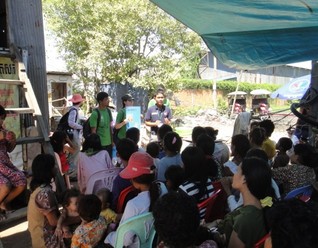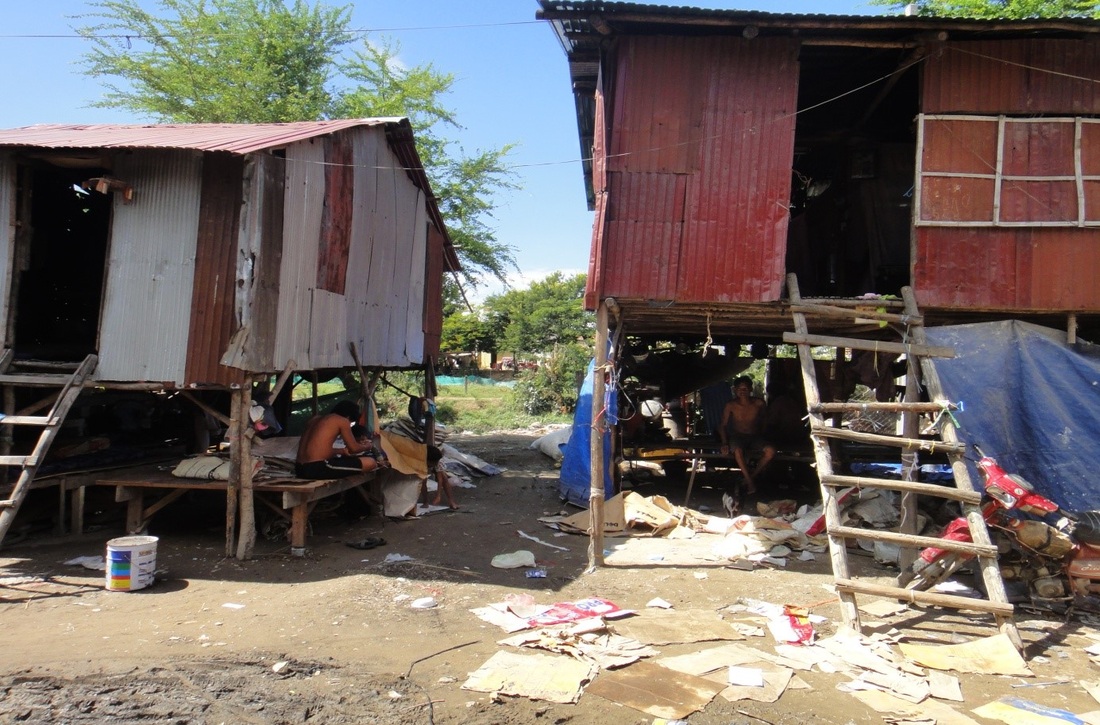
Jisoo Lee
On the second day in Cambodia, we visited two slums, Canal Side slum and House Above the Water slum. Before visiting the slums, we first met the One2One team in their office. The office seemed somewhat small to fit many doctors, nurses, and volunteers, but all the team members seemed energetic nonetheless. I was especially inspired by Dr. Anne who was the director of the One2One team. Although it was the first time meeting her, she gave all of us a warm welcome and thanked us for coming to Cambodia to do good things. At this moment when I first met Dr. Anne, I could feel that she was going to be a great help throughout the entire trip in Cambodia.
As we got off our coach to walk to the Canal Side slum, I got a first glimpse of what a slum is like. I have never lived in an environment where transportation was unavailable, but in the slums in Cambodia, vehicles bigger than tuk-tuk could not go through the narrow and unpaved road to the entrance to the slum. This was one of the primary reasons that the medical team used the tuk-tuk to transport their people and luggage such as tables, chairs, and medical devices. Although it would be much more convenient for them to use a small coach to transport the people and luggage, the conditions of the slum and the high maintenance cost made them give up the idea of using such transportation. When we arrived at the first slum, I observed how the One2One team set up the nursing station. Because it was a nursing station but not a medical station, the setup was relatively simple, but setting up the canopy, which required a lot of man force and time, seemed to be a big problem. When the setup was finished, I had a chance to look around the slum and ask one of the slum residents some questions with the assistance of one One2One team member. The Canal Side slum seemed to be in a relatively good condition. The environment was not as bad as I had imagined, and there were even two public toilets that were kept quite clean. After taking a look around the slum, my group had to give a health demonstration on hand washing to the slum residents. There were so many uncertainties regarding this health promotion before coming to Cambodia, so I was worried at first, but it went quite successfully. There were more people than I had expected, the people were very much open to us and listened to what we were saying, and all of them stayed in good order. We had opportunities to interview the residents after the health promotion, which gave us valuable insight into the health situation in the slum.
In the second slum, House Above the Water slum, the medical team went instead of the nursing team. In contrast to the nursing team, the medical team had three stations, the triage, doctor, and the pharmacy. I observed how the pharmacy worked in this slum. It was interesting how pharmacist put a paper showing pictures of a rising sun, a sun high up in the sky, and a setting sun to indicate when the patient should take the medication. It was a consideration for most of the residents who were illiterate. Through this simple act, I could see how much effort the One2One team put into making the medical service more convenient for the residents.
On the second day in Cambodia, we visited two slums, Canal Side slum and House Above the Water slum. Before visiting the slums, we first met the One2One team in their office. The office seemed somewhat small to fit many doctors, nurses, and volunteers, but all the team members seemed energetic nonetheless. I was especially inspired by Dr. Anne who was the director of the One2One team. Although it was the first time meeting her, she gave all of us a warm welcome and thanked us for coming to Cambodia to do good things. At this moment when I first met Dr. Anne, I could feel that she was going to be a great help throughout the entire trip in Cambodia.
As we got off our coach to walk to the Canal Side slum, I got a first glimpse of what a slum is like. I have never lived in an environment where transportation was unavailable, but in the slums in Cambodia, vehicles bigger than tuk-tuk could not go through the narrow and unpaved road to the entrance to the slum. This was one of the primary reasons that the medical team used the tuk-tuk to transport their people and luggage such as tables, chairs, and medical devices. Although it would be much more convenient for them to use a small coach to transport the people and luggage, the conditions of the slum and the high maintenance cost made them give up the idea of using such transportation. When we arrived at the first slum, I observed how the One2One team set up the nursing station. Because it was a nursing station but not a medical station, the setup was relatively simple, but setting up the canopy, which required a lot of man force and time, seemed to be a big problem. When the setup was finished, I had a chance to look around the slum and ask one of the slum residents some questions with the assistance of one One2One team member. The Canal Side slum seemed to be in a relatively good condition. The environment was not as bad as I had imagined, and there were even two public toilets that were kept quite clean. After taking a look around the slum, my group had to give a health demonstration on hand washing to the slum residents. There were so many uncertainties regarding this health promotion before coming to Cambodia, so I was worried at first, but it went quite successfully. There were more people than I had expected, the people were very much open to us and listened to what we were saying, and all of them stayed in good order. We had opportunities to interview the residents after the health promotion, which gave us valuable insight into the health situation in the slum.
In the second slum, House Above the Water slum, the medical team went instead of the nursing team. In contrast to the nursing team, the medical team had three stations, the triage, doctor, and the pharmacy. I observed how the pharmacy worked in this slum. It was interesting how pharmacist put a paper showing pictures of a rising sun, a sun high up in the sky, and a setting sun to indicate when the patient should take the medication. It was a consideration for most of the residents who were illiterate. Through this simple act, I could see how much effort the One2One team put into making the medical service more convenient for the residents.


 RSS Feed
RSS Feed
